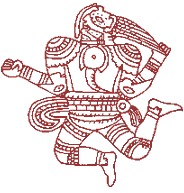![]()

Historical Texas Indians
Defining the historic Indian tribes in Texas is not easy. Different tribes occupied different regions at different times. This is why we have divided the subject into Proto-historical, at the time of first contact with early explorers, at the time of the Spanish missions and settlement, and contact after 1800s sections. The Proto-historical tribes are those found just prior to and at first European contact. These are the tribes described by DeSoto in 1542 and Cabeza de Vaca in 1535. They had changed dramatically by the time of the Spanish missions. Moses and Stephen Austin and their Colonist and the flood of settlers that soon followed in the 1800s found yet another group of tribes. There are several interrelated reasons for this. Diseases introduced by the first Europeans killed up to 80% of the population of many tribes, reducing them to mere shadows of their former glory and destroying their cultures and traditions. Often groups of survivors would band together to form new bands. Many tribes simply became extinct, often before any European described them. The first European contact also closely coincided with the arrival of aggressive and powerful tribes coming down from the Great Plains. The Apachean tribes had began to settle in the Pan-handle just prior to Coronado's arrival in 1541. After the Pueblo revolt of 1680 the southern plains tribes acquired the horse in large numbers, they were then even more aggressive and more formidable than before. Tribes in contact with the French along the Missouri river and on the Mississippi river acquired firearms. These better armed tribes expanded forcing other tribes south and west. This created a domino effect. For example, the Apaches were forced south into the Edwards Plateau area of central Texas by the Comache and other plains tribes coming out of the north. This is were the Spanish found them in the 1700s. By the time of the German settlers arrived in the early and middle 1800s the Comanche were in control of the Edwards Plateau and the Apaches were gone and the Tonkawa tribe had moved from North East Texas into the central Texas region just east of the plateau. This is why we have choosen to divide the tribes into time periods. The other way to divide the tribes and bands is by region. Tribes and bands tended to stay as long as they could in the physiographical environmental zones that they were best adapted to exploit for food and shelter. Within these physiographic zones bands and subgroups of the tribe each had its own territory. Hunter-gatherer groups in the desert west and along the coast would move seasonally to the best resources across large areas. Tribes in east Texas with agriculture were sedentary, living in villages. These Caddoan tribes supported large populations and exerted political influence over large regions with multiple villages, usually in river valleys.
THE FIRST CONTACTS.
The accounts of the first contacts are very valuable. They describe pristine Indian tribes, people, customs, material goods, patterns of life, that disappeared in a generation or two. DeSoto and Coronado, describe tribes and bands that would be gone by the next recorded European contact. Even by the time of Cabeza de Vaca, epidemics of European disease from slavers and pirates contact had killed huge numbers of Indians, destroying whole tribes and civilizations in the process. De Vaca recorded that the groups he met were already stressed by unusal epidemics and deaths. These earliest accounts are the only eye witness evidence we have of many tribes and cultures.
Groups Found at the Time of the First Spanish Missions
- Cohuiltecans in South Texas.
- Coastal tribes and bands.
- Caddo tribes in East Texas.
- Apaches in West Texas and the Edwards Plateau.
- Tonkawas in Central Texas.
Groups Found at the Start of the 1800s
- Comanches.
- Karankawa